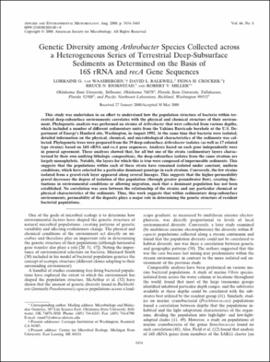| dc.contributor.author | van Waasbergen, Lorraine G. | |
| dc.contributor.author | Balkwill, David L. | |
| dc.contributor.author | Crocker, Fiona H. | |
| dc.contributor.author | Bjornstad, Bruce N. | |
| dc.contributor.author | Miller, Robert V. | |
| dc.date.accessioned | 2015-10-16T20:48:00Z | |
| dc.date.available | 2015-10-16T20:48:00Z | |
| dc.date.issued | 2000-08 | |
| dc.identifier | okds_Ford-Miller_AEM_2000-08.pdf | |
| dc.identifier.citation | van Waasbergen, L. G., Balkwill, D. L., Crocker, F. H., Bjornstad, B. N., & Miller, R. V. (2000). Genetic diversity among Arthrobacter species collected across a heterogeneous series of terrestrial deep-subsurface sediments as determined on the basis of 16S rRNA and recA gene sequences. Applied and Environmental Microbiology, 66(8), 3454-3463. https://doi.org/10.1128/aem.66.8.3454-3463.2000 | |
| dc.identifier.uri | https://hdl.handle.net/11244/19830 | |
| dc.description.abstract | This study was undertaken in an effort to understand how the population structure of bacteria within terrestrial deep-subsurface environments correlates with the physical and chemical structure of their environment. Phylogenetic analysis was performed on strains of Arthrobacter that were collected from various depths, which included a number of different sedimentary units from the Yakima Barricade borehole at the U.S. Department of Energy's Hanford site, Washington, in August 1992. At the same time that bacteria were isolated, detailed information on the physical, chemical, and microbiological characteristics of the sediments was collected. Phylogenetic trees were prepared from the 39 deep-subsurface Arthrobacter isolates (as well as 17 related type strains) based on 16S rRNA and recA gene sequences. Analyses based on each gene independently were in general agreement. These analyses showed that, for all but one of the strata (sedimentary layers characterized by their own unifying lithologic composition), the deep-subsurface isolates from the same stratum are largely monophyletic. Notably, the layers for which this is true were composed of impermeable sediments. This suggests that the populations within each of these strata have remained isolated under constant, uniform conditions, which have selected for a particular dominant genotype in each stratum. Conversely, the few strains isolated from a gravel-rich layer appeared along several lineages. This suggests that the higher-permeability gravel decreases the degree of isolation of this population (through greater groundwater flow), creating fluctuations in environmental conditions or allowing migration, such that a dominant population has not been established. No correlation was seen between the relationship of the strains and any particular chemical or physical characteristics of the sediments. Thus, this work suggests that within sedimentary deep-subsurface environments, permeability of the deposits plays a major role in determining the genetic structure of resident bacterial populations. | |
| dc.format | application/pdf | |
| dc.language | en_US | |
| dc.publisher | American Society for Microbiology | |
| dc.rights | This material has been previously published. In the Oklahoma State University Library's institutional repository this version is made available through the open access principles and the terms of agreement/consent between the author(s) and the publisher. The permission policy on the use, reproduction or distribution of the material falls under fair use for educational, scholarship, and research purposes. Contact Digital Resources and Discovery Services at lib-dls@okstate.edu or 405-744-9161 for further information. | |
| dc.title | Genetic diversity among Arthrobacter species collected across a heterogeneous series of terrestrial deep-subsurface sediments as determined on the basis of 16S rRNA and recA gene sequences | |
| osu.filename | okds_Miller_AEM_2000-08.pdf | |
| dc.description.peerreview | Peer reviewed | |
| dc.identifier.doi | 10.1128/AEM.66.8.3454-3463.2000 | |
| dc.description.department | Microbiology and Molecular Genetics | |
| dc.type.genre | Article | |
| dc.type.material | Text | |
